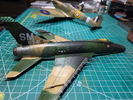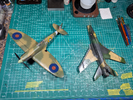- Joined
- Dec 1, 2024
- Messages
- 369
Fully cured Tamiya X and XF paints are dissolved by ~90% isopropyl alcohol.
Remind me again what "MLT" is?
Remind me again what "MLT" is?
I find that a little odd, given that the pre-shading technique depends on what you seem to be very good at: spraying thin layers that don't cover well, so you can control how much of the pre-shade comes through.here are 10-15 layers of paint sprayed extremely thin as if what they call a "filter" that I do as post-shading. I found pre-shading harder to control by the time I came to the end.
Mr. Leveling Thinner.Remind me again what "MLT" is?
Indeed. I think I can explain the dichotomy simply.I find that a little odd, given that the pre-shading technique depends on what you seem to be very good at: spraying thin layers that don't cover well, so you can control how much of the pre-shade comes through.
That is almost an understatement! I think roughly 30%, with ~70% water is a good compromise.Fully cured Tamiya X and XF paints are dissolved by ~90% isopropyl alcohol.
One reason I left all the danger/caution stickers off of that section. I looked at tons of photos and there's no sign of the red walk-lines on the wings, or the red stripes where the rear fuselage separates for maintenance. The last picture (above) that Jakko posted shows them clearly, and most of the bare-metal Huns had them. I'm guessing they applied the SEA camo on top of nearly everything.When that paint gets hot enough (and the discolored metal is proof that it was hot enough) the paint burns...


